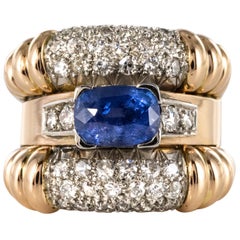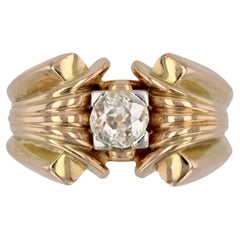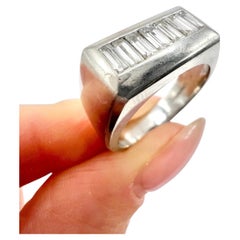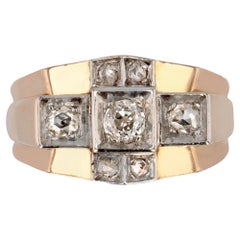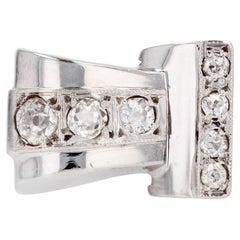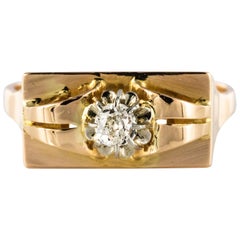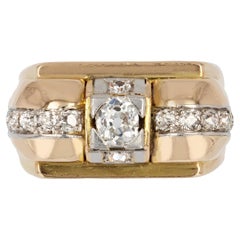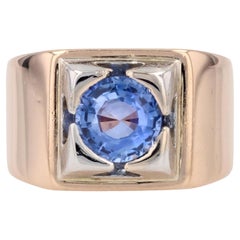Tank Ring 1940s
Mid-20th Century European Cocktail Rings
Diamond, Platinum
Vintage 1940s French Retro Dome Rings
Blue Sapphire, Sapphire, White Diamond, Diamond, Gold, Platinum, Yellow ...
Vintage 1940s French Retro Signet Rings
White Diamond, Diamond, Yellow Gold, 18k Gold, Gold
Mid-20th Century European Band Rings
Diamond, Platinum
Vintage 1940s French Retro Dome Rings
White Diamond, Diamond, Platinum, Gold, Rose Gold, 18k Gold
Vintage 1940s French Retro Signet Rings
Diamond, White Diamond, Gold, 18k Gold
Vintage 1940s French Retro Cocktail Rings
White Diamond, Diamond, Gold, Platinum, Yellow Gold, 18k Gold
Vintage 1940s French Retro Signet Rings
White Diamond, Diamond, Yellow Gold, Platinum, 18k Gold, Gold
Vintage 1940s French Retro Signet Rings
Blue Sapphire, Sapphire, Platinum, Yellow Gold, 18k Gold, Gold
Vintage 1940s French Retro Signet Rings
White Diamond, Diamond, Yellow Gold, 18k Gold, Gold
Vintage 1940s French Retro Signet Rings
Blue Sapphire, Sapphire, White Diamond, Diamond, Rose Gold, Gold, 18k Gold
Vintage 1940s French Retro Dome Rings
Diamond, White Diamond, Gold, 18k Gold, Rose Gold
Vintage 1940s French Retro Dome Rings
White Diamond, Diamond, Yellow Gold, Gold, Platinum, 18k Gold
Vintage 1940s French Retro Dome Rings
Emerald, White Diamond, Diamond, Rose Gold, Platinum, 18k Gold, Gold
Vintage 1940s French Retro Dome Rings
Diamond, White Diamond, Gold, 18k Gold, Rose Gold, Platinum
Vintage 1940s French Retro Signet Rings
White Diamond, Diamond, Rose Gold, 18k Gold, Gold
Vintage 1940s French Retro Signet Rings
Ruby, White Diamond, Diamond, Yellow Gold, Platinum, 18k Gold, Gold
Vintage 1940s French Retro Signet Rings
Diamond, White Diamond, Sapphire, Blue Sapphire, Gold, 18k Gold, Rose Gold
Vintage 1940s French Retro Signet Rings
White Diamond, Diamond, Platinum, Yellow Gold, 18k Gold, Gold
Vintage 1940s French Retro Cocktail Rings
Diamond, Platinum
Vintage 1940s French Retro Signet Rings
Ruby, White Diamond, Diamond, Rose Gold, 18k Gold, Gold
Vintage 1940s French Retro Cocktail Rings
Natural Pearl, Pearl, White Diamond, Diamond, Yellow Gold, Platinum, 18k...
Vintage 1940s French Retro Signet Rings
White Diamond, Diamond, 18k Gold, Platinum, Yellow Gold, Gold
Vintage 1940s French Retro Signet Rings
Diamond, White Diamond, Gold, 18k Gold, Rose Gold
Vintage 1940s French Retro Signet Rings
Natural Pearl, Pearl, White Diamond, Diamond, Platinum, Yellow Gold, 18k...
Vintage 1940s French Retro Signet Rings
Diamond, White Diamond, Gold, 18k Gold, Yellow Gold, Platinum
Mid-20th Century French Cocktail Rings
Diamond, 18k Gold, Yellow Gold, Platinum
Vintage 1940s French Retro Cocktail Rings
White Diamond, Diamond, Platinum, Gold, Rose Gold, 18k Gold
Vintage 1940s French Retro Signet Rings
Sapphire, Blue Sapphire, Ruby, White Diamond, Diamond, Gold, Yellow Gold...
Mid-20th Century European Cocktail Rings
Diamond, Ruby, 18k Gold, Rose Gold
Vintage 1940s French Retro Three-Stone Rings
Sapphire, Gold, 18k Gold, Rose Gold
Vintage 1940s Art Deco Cocktail Rings
Diamond, Sapphire, 18k Gold, Yellow Gold, Platinum
Vintage 1940s Art Deco Cocktail Rings
Diamond, Ruby, 14k Gold, Rose Gold, Platinum
Mid-20th Century French Retro Cocktail Rings
Diamond, Sapphire, 18k Gold, Yellow Gold
Vintage 1930s French Retro Loose Gemstones
Diamond, Ruby, 18k Gold, White Gold, Yellow Gold
Vintage 1930s French Retro Drop Earrings
Diamond, Ruby, 18k Gold, White Gold, Yellow Gold
Vintage 1940s French Retro Signet Rings
White Diamond, Diamond, Gold, Platinum, Yellow Gold, 18k Gold
Vintage 1940s French Retro Fashion Rings
White Diamond, Diamond, Yellow Gold, 18k Gold, Gold
Mid-20th Century French Modern Cocktail Rings
Diamond, Ruby, Yellow Gold
Mid-20th Century French Retro Cocktail Rings
Diamond, Ruby, Yellow Gold
Vintage 1940s French Retro Cocktail Rings
Diamond, White Diamond, Gold, 18k Gold, Yellow Gold
Vintage 1940s French Retro Dome Rings
Diamond, White Diamond, Ruby, Gold, 18k Gold, Yellow Gold
Vintage 1940s French Retro Dome Rings
White Diamond, Diamond, Gold, 18k Gold, Yellow Gold, Platinum
Vintage 1950s French Retro Signet Rings
Diamond, White Diamond, 18k Gold, Gold, Yellow Gold
Vintage 1940s French Retro Signet Rings
Yellow Gold, Silver, Sterling Silver, Gold
Vintage 1940s French Retro Signet Rings
White Diamond, Diamond, Rose Gold, 18k Gold, Gold
Vintage 1940s French Retro Signet Rings
Diamond, White Diamond, 18k Gold, Gold, Platinum, Yellow Gold
Vintage 1930s Unknown Retro Band Rings
Diamond, Yellow Gold, Gold, 18k Gold, White Gold
Vintage 1940s French Retro Cocktail Rings
Diamond, White Diamond, Gold, 18k Gold, Yellow Gold
Vintage 1940s French Retro Cocktail Rings
Emerald, Diamond, White Diamond, Gold, 18k Gold, Yellow Gold
Vintage 1940s French Retro Cocktail Rings
Diamond, White Diamond, Emerald, Gold, 18k Gold, Yellow Gold
Vintage 1940s French Retro Signet Rings
Diamond, White Diamond, Gold, 18k Gold, Rose Gold
Vintage 1940s French Retro Signet Rings
Diamond, White Diamond, 18k Gold, Yellow Gold, Gold
Vintage 1940s French Retro Signet Rings
Blue Sapphire, Sapphire, White Diamond, Diamond, Platinum, Yellow Gold, ...
Vintage 1940s French Retro Signet Rings
Diamond, White Diamond, Gold, 18k Gold, Yellow Gold, Platinum
Vintage 1940s French Retro Dome Rings
Gold, 18k Gold, Yellow Gold
Vintage 1940s French Retro Signet Rings
Diamond, White Diamond, Gold, 18k Gold, Rose Gold, Platinum
Vintage 1940s French Retro Cocktail Rings
Gold, 18k Gold, White Gold, Yellow Gold
Vintage 1940s French Retro Signet Rings
Diamond, White Diamond, Gold, 18k Gold, Yellow Gold, Platinum
Vintage 1940s French Retro Dome Rings
Diamond, White Diamond, Gold, 18k Gold, Yellow Gold, Platinum
- 1
Tank Ring 1940s For Sale on 1stDibs
How Much are Tank Ring 1940s?
Why Gold Shines in Jewelry Craftsmanship
Gold is the feel-good metal, the serotonin of jewelry. Wear vintage and antique gold necklaces, watches, gold bracelets or gold rings and you feel happy, you feel dressed, you feel, well, yourself.
Gold, especially yellow gold, with its rich patina and ancient pedigree going back thousands of years, is the steady standby, the well-mannered metal of choice. Any discussion of this lustrous metal comes down to a basic truth: Gold is elementary, my dear. Gold jewelry that couples the mystique of the metal with superb design and craftsmanship achieves the status of an enduring classic. Many luxury houses have given us some of our most treasured and lasting examples of gold jewelry over the years.
Since its founding, in 1837, Tiffany & Co. has built its reputation on its company jewelry as well as its coterie of boutique designers, which has included Jean Schlumberger, Donald Claflin, Angela Cummings and Elsa Peretti. There are numerous gold Tiffany classics worth citing. Some are accented with gemstones, but all stand out for their design and the workmanship displayed.
For the woman who prefers a minimalist look, the Tiffany & Co. twist bangle (thin, slightly ovoid) is stylishly simple. For Cummings devotees, signature pieces feature hard stone inlay, such as her pairs of gold ear clips inlaid with black jade (a play on the classic Chanel black and tan), or bangles whose design recalls ocean waves, with undulating lines of lapis lazuli and mother-of-pearl. And just about any design by the great Jean Schlumberger is by definition a classic.
Even had he eschewed stones and diamonds, Southern-born David Webb would be hailed for the vast arsenal of heavy gold jewelry he designed. Gold, usually hammered or textured in some manner, defines great David Webb jewelry. The self-taught jeweler made very au courant pieces while drawing inspiration from ancient and out-of-the-way sources — East meets West in the commanding gold necklaces made by Webb in the early 1970s. The same could be said for his endlessly varied gold cuffs.
In Europe, many houses have given us gold jewelry that sets the highest standard for excellence, pieces that were highly sought after when they were made and continue to be so.
Numerous designs from Cartier are homages to gold. There are the classic Trinity rings, necklaces and bracelets — trifectas of yellow, white and rose gold. As a testament to the power of love, consider the endurance of the Cartier Love bracelet.
Aldo Cipullo, Cartier’s top in-house designer from the late 1960s into the early ’70s, made history in 1969 with the Love bracelet. Cipullo frequently said that the Love bracelet was born of a sleepless night contemplating a love affair gone wrong and his realization that “the only remnants he possessed of the romance were memories.” He distilled the urge to keep a loved one close into a slim 18-karat gold bangle.
BVLGARI and its coin jewelry, gemme nummarie, hit the jackpot when the line launched in the 1960s. The line has been perennially popular. BVLGARI coin jewelry features ancient Greek and Roman coins embedded in striking gold mounts, usually hung on thick link necklaces of varying lengths. In the 1970s, BVLGARI introduced the Tubogas line, most often made in yellow gold. The Tubogas watches are classics, and then there is the Serpenti, the house's outstanding snake-themed watches and bracelets.
A collection called Monete that incorporated the gold coins is one of several iconic BVLGARI lines that debuted in the 1970s and ’80s, catering to a new generation of empowered women. Just as designers like Halston and Yves Saint Laurent were popularizing fuss-free ready-to-wear fashion for women on the go, BVLGARI offered jewels to be lived in.
Since Van Cleef & Arpels opened its Place Vendôme doors in 1906, collection after collection of jewelry classics have enchanted the public. As predominantly expressed in a honeycomb of gold, there is the Ludo watch and accessories, circa the 1920s, and the golden Zip necklace, 1951, whose ingenious transformation of the traditional zipper was originally proposed by the Duchess of Windsor. Van Cleef's Alhambra, with its Moroccan motif, was introduced in 1968 and from the start its popularity pivoted on royalty and celebrity status. It remains one of VCA’s most popular and collected styles.
Mention must be made of Buccellati, whose name is synonymous with gold so finely spun that it suggests tapestry. The house’s many gold bracelets, typically embellished with a few or many diamonds, signified taste and distinction and are always in favor on the secondary market. Other important mid-20th-century houses known for their gold-themed jewelry include Hermès and Ilias Lalaounis.
Find a stunning collection of vintage and antique gold jewelry on 1stDibs.
The Legacy of Diamond in Jewelry Design
Antique diamond rings, diamond tiaras and dazzling vintage diamond earrings are on the wish lists of every lover of fine jewelry. And diamonds and diamond jewelry are primarily associated with storybook engagements and red-carpet grand entrances — indeed, this ultra-cherished gemstone has a dramatic history on its hands.
From “A Diamond Is Forever” to “Diamonds Are a Girl’s Best Friend,” pop culture has ingrained in our minds that diamonds are the most desired, the most lasting and the most valuable gemstone. But what makes the diamond so special? Each stone — whether it’s rubies, sapphires or another stone — is unique and important in its own right. April babies might claim diamonds for themselves, but just about everyone wants this kind of sparkle in their lives!
There are several factors that set diamonds apart from other stones, and these points are important to our gem education.
Diamonds are minerals. They are made up of almost entirely of carbon (carbon comprises 99.95 percent; the remainder consists of various trace elements). Diamonds are the hardest gemstones, ranking number 10 on the Mohs Hardness Scale. Even its name, diamond, is rooted in the Greek adamas, or unconquerable. The only object that can scratch a diamond is another diamond. Diamonds are formed deep within the earth at very high temperatures (1,652–2,372 degrees Fahrenheit at depths between 90 and 120 miles beneath the earth’s surface) and are carried up by volcanic activity. Diamonds are quite rare, according to the Gemological Institute of America, and only 30 percent of all the diamonds mined in the world are gem quality.
In the 1950s, the Gemological Institute of America developed the 4Cs grading system to classify diamonds: clarity, color, cut and carat weight. Not all diamonds are created equal (there are diamonds, and then there are diamonds). The value of the diamond depends on the clarity (flawless diamonds are very rare but a diamond's value decreases if there are many blemishes or inclusions), color (the less color the higher the grade), cut (how the diamond’s facets catch the light, certain cuts of diamonds show off the stone better than others) and carat weight (the bigger, the better).
When you start shopping for a diamond engagement ring, always prioritize the cut, which plays the largest role in the diamond's beauty (taking the time to clean your diamond ring at least every six months or so plays a role in maintaining said beauty). And on 1stDibs, a range of buying guides can be found for those in the market for antique engagement rings, vintage engagement rings or Art Deco engagement rings.
Shop antique and vintage diamond rings, diamond necklaces and other extraordinary diamond jewelry on 1stDibs.
Finding the Right Rings for You
Antique and vintage rings have long held a special place in the hearts of fine jewelry lovers all over the world.
No matter their origin or specific characteristics, rings are timeless, versatile accessories. They’ve carried deep meaning since at least the Middle Ages, when diamond rings symbolized strength and other kinds of rings were worn to signify romantic feelings or to denote an affiliation with a religious order. Rings have also forever been emblematic of eternity.
Over time, rings have frequently taken the form of serpents, which have long been associated with eternal life, health and renewal. Italian luxury jewelry house Bulgari has become famous for its widely loved Serpenti motif, for example, and its Serpenti ring, like the other accessories in the collection, began as an homage to jewelry of the Roman and Hellenistic eras. The serpent is now a popular motif in fine jewelry. Jewelry devotees have long pined for rings adorned with reptiles, thanks to antique Victorian rings — well, specifically, Queen Victoria’s illustrious engagement ring, which took the form of a gold snake set with rubies, diamonds and an emerald (her birthstone). Designs for Victorian-era engagement rings often featured repoussé work and chasing, in which patterns are hammered into the metal.
Engagement rings, which are reliably intimidating to shop for, are still widely recognized as symbols of love and commitment. On 1stDibs, a range of buying guides can be found for those in the market for antique engagement rings, vintage engagement rings or Art Deco engagement rings.
The most collectible antique engagement rings and vintage engagement rings are those from the Victorian, Edwardian and Art Deco eras. Named for the monarchies of the four King Georges, who in succession ruled England starting in 1714 (plus King William’s reign), antique Georgian rings, be they engagement rings or otherwise, are also coveted by collectors. Pearls, along with colored gemstones like garnets, rubies and sapphires, were widely used in Georgian jewelry. The late-1700s paste jewelry was a predecessor to what we now call fashion or costume jewelry.
The Art Nouveau movement (1880–1910) brought with it rings inspired by the natural world. Antique Art Nouveau rings might feature depictions of winged insects and fauna as well as women, who were simultaneously eroticized and romanticized, frequently with long flowing hair. Art Deco jewelry, on the other hand, which originated during the 1920s and ’30s, is by and large “white jewelry.” White metals, primarily platinum, were favored over yellow gold in the design of antique Art Deco rings and other accessories as well as geometric motifs, with women drawn to the era’s dazzling cocktail rings in particular.
Whether you’re hunting down a chunky classic for a Prohibition-themed cocktail party or seeking a clean contemporary design to complement your casual ensemble, find an exquisite collection of antique, new and vintage rings on 1stDibs.
- 1stDibs ExpertFebruary 22, 2021In the 1940s, ladies wore clothes defined by clean and slim silhouettes. The jackets, blouses and sweaters often featured shoulderpads and had somewhat of a military feel. Most dresses were quite casual and pants and playsuits became part of a woman's everyday style.
- 1stDibs ExpertApril 5, 2022A number of dresses were popular during the 1940s. Many women wore short-waist dresses with button necks, collars, fitted waists and full skirts. The classic A-lines with knee-length hems in red, white and blue colors were also a trend. Shop a collection of vintage dresses on 1stDibs.
- What is a 1940s style dress?1 Answer1stDibs ExpertOctober 5, 2021The most popular 1940s-style dress was the shirtwaist dress. It had a front opening like a men’s shirt, but with large buttons in the front of the dress, which was practical and easy to wear. The sleeves were short and necklines varied from shirt style to sweetheart and other necklines. Antique and vintage dresses from well-known designers are available on 1stDibs.
- What is a 925s ring?1 Answer1stDibs ExpertApril 5, 2022A 925s ring is a piece of jewelry worn on a finger made of a specific type of precious metal. Specifically, 925s indicated 925 sterling silver. This metal is 92.5 percent pure silver, and the remaining 7.5 percent is another metal like copper. Shop a wide range of sterling silver rings on 1stDibs.
- 1stDibs ExpertSeptember 23, 2024Claire McCardell was the designer often called the Mother of American Fashion in the 1940s. An American designer, she helped introduce women's sportswear to the United States and was particularly well-known for her bias-cut, loose-fitting Monastic dress. When World War II broke out in the 1940s, she designed pieces out of readily available materials like denim, calico and wool jersey, introducing new fabrics for women's clothing that would remain popular well after the close of the war. Many people point to McCardell as one of the first successful American fashion designers. Shop a collection of Claire McCardell apparel on 1stDibs.
- 1stDibs ExpertDecember 4, 2023Yes, they did have wedding rings during the 1600s. However, exchanging rings during weddings was not common in all cultures. In Europe, many couples presented each other with rings to symbolize their marriage vows. The wedding ring tradition actually dates back thousands of years to ancient Egypt, Greece and Rome. Explore a wide variety of wedding rings on 1stDibs.
- 1stDibs ExpertNovember 21, 2023In the 1920s, engagement rings still looked like rings but were representative of a diverse range of styles and influences. Art Deco diamond ring designs took inspiration from the contemporary Cubist movement as well as from ancient Egypt – a revival sparked by the opening of King Tut’s tomb in 1922. Native American, African and Asian motifs also inspired jewelry pieces. Diamonds in square and rectangular shapes incorporating angular steps – like emerald cuts, Asscher cuts and baguettes – were set against black onyx, rubies, sapphires and emeralds to create color-blocking effects. Platinum, 18-karat gold, 14-karat white gold and sterling silver were some of the favored metals of the decade. Find a wide range of Art Deco engagement rings on 1stDibs.
- 1stDibs ExpertDecember 4, 2023What wedding rings looked like in the 1800s was similar to other Victorian jewelry. The Victorian era spanned from 1837 to 1901, coinciding with the reign of Queen Victoria in the United Kingdom. At the beginning of this period, rings were made of gold and affordable only to the wealthy. Designs for Victorian-era rings often featured repoussé work and chasing, in which patterns are hammered into the metal. Some featured stones secured by collets, settings similar to bezels, with prongs and a closed back. On 1stDibs, find a selection of Victorian wedding rings.
- 1stDibs ExpertNovember 21, 2023In the early 1900s, engagement rings often looked like other jewelry from the Edwardian era, which coincided with the reign of King Edward VII in the United Kingdom from 1901 to 1910. Cutters used new diamond saws and jewelry lathes to refine the old European cut. The resulting stones, designed to sparkle in the light from candles and gas lamps, are beloved by connoisseurs for their inner fire and romantic glow. The invention of the oxyacetylene torch enabled jewelers to use platinum, which had previously been too challenging to work with. This technological advancement made it possible for Edwardian rings to show off lacy filigree and milgrain work. Nature also influenced jewelry in the early 1900s. Flowing and floral garland motifs were so popular that the Edwardian age is sometimes called the "garland era." Find a selection of Edwardian engagement rings on 1stDibs.

